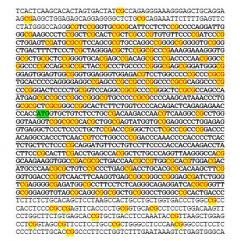Step forward in deciphering how our genes are controlled
A protein (CFP1) known to regulate a class of genes also targets another, unexpected class of genes, to switch them on, scientists found.

DNA serves as the blueprint for life and is made up of four key building blocks, written as A, T, C and G. These letters are not in a random order and within the genome there are 25,000 coded messages called genes which control many parts of our body, its regulation and its development.
Although genes are very important, the letters that make them up only constitute around 1% of three billion building blocks that make up our genome – what the rest of the genome is doing is still an active area of research.
Patterns in DNA
These uncoded regions contain certain patterns. Some sections have huge repetitions of certain building blocks, some parts control the expression of genes and some are very important for the structure of our chromosome. Of particular interest, some of these regions contain high amounts of C and G, and are known as CpG islands (CGIs).
These CGIs are often found next to genes which are continuously active within our cells. These types of genes are called housekeeping genes as they are always kept on and they help the cell with its normal functions.
Unlike housekeeping genes, many genes are turned on and off during development or under environmental changes such as stress. How these genes are regulated or controlled has been an important scientific question over the last decades.
Despite CGIs being found near housekeeping genes, they have also been found to take part in turning on and off many genes regulated by development. Binding of specific groups of proteins to these CGIs provides a mechanism to restrict the activity of the genes near these CGIs to the right cell type.
One of these binding proteins is called CFP1 and when this binds to a CGI, it causes the neighbouring gene to be kept on so that it can be expressed, that is converted from DNA to protein.
Role in gene activity
In a study led by Dr Douglas Vernimmen at the Roslin Institute, the location of CFP1 in the genome was looked at in two different types of blood cells. The study found that CFP1 targets active genes in both cell types but, despite earlier reports of them targeting CGIs, it was found that CFP1 also binds to active genes with very little amounts of C and G.
In addition, CFP1 was also found at other parts of the genome involved in controlling gene activity, called distant enhancer elements. What the researchers concluded from this was that CFP1 appears to act to keep genes on, regardless of their CpG content. These findings help to make sense of the complex genomic codes that control gene activity.
This research has helped to redefine the specificity of CFP1 protein. It was previously thought it only bound to C and G rich regions of DNA, but in our study, we have found that CFP1 helps to maintain genes in an active state, regardless of CpG content, and therefore defining a much broader role for this protein. This is a step forward in figuring out how our genes are regulated and controlled, and re-question the role of genomic features such as C and G rich regions.
The study has been funded by the UK's Biotechnology and Biological Sciences Research Council is published in the journal "Epigenetics & Chromatin".
Related links
Prestigious fellowship to investigate Influenza A virus
Understanding how kidneys are built
Chromatin Biology and Epigenetics group


